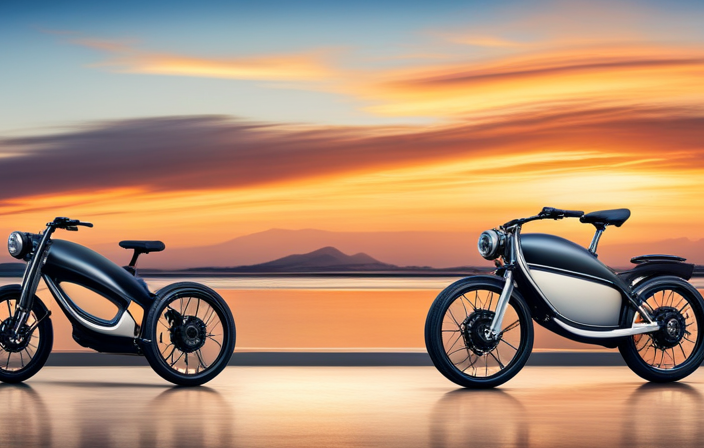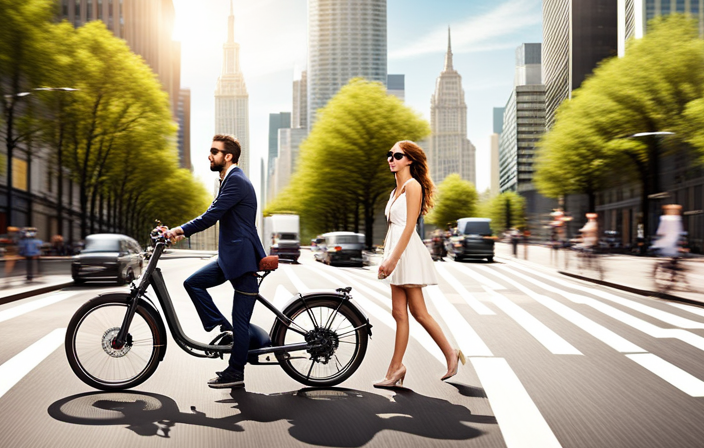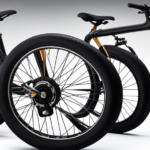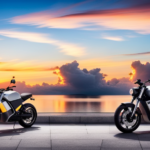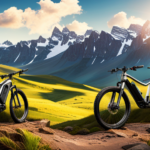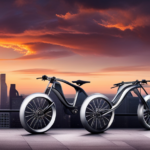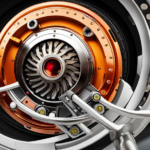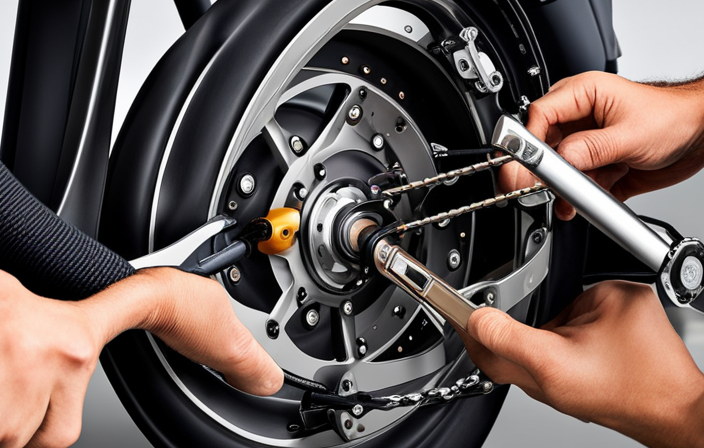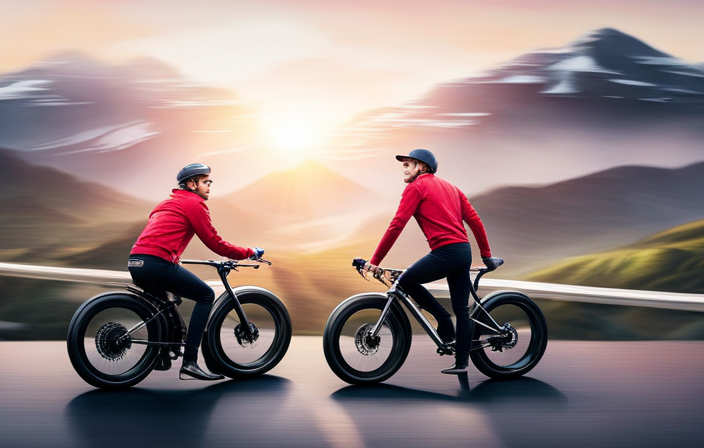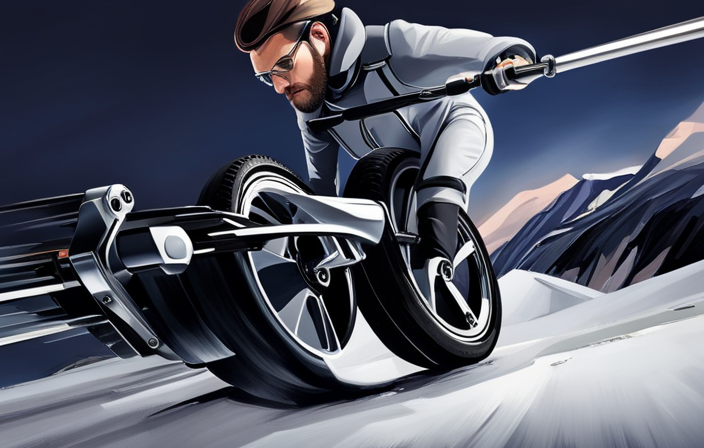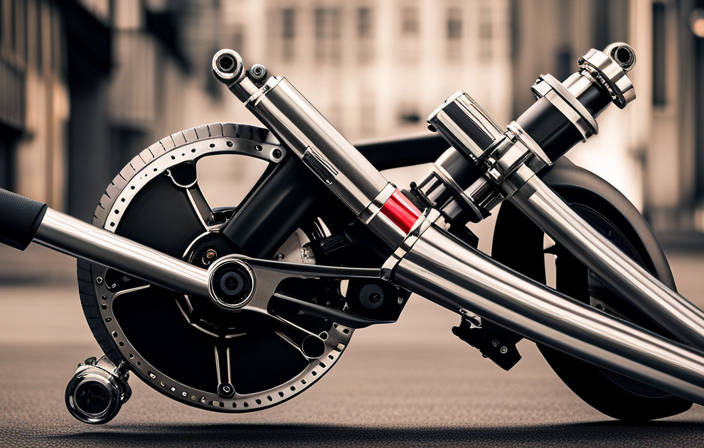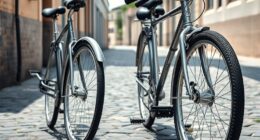As an avid cyclist, I’ve always been fascinated by the mechanics of electric bikes. The question of which motor configuration is faster – rear or front – has intrigued me for some time.
In this article, we will delve into the intricacies of electric bike motors and analyze the pros and cons of both rear and front configurations. Moreover, we will conduct a speed comparison between the two to determine which motor reigns supreme.
So, hop on and join me in this exciting journey to uncover the truth behind electric bike speed.
Key Takeaways
- Rear motors offer better traction and stability.
- Front motors offer a more natural riding experience.
- Rear motors offer more power and torque.
- Front motors allow for easier maneuverability.
Understanding the Basics of Electric Bike Motors
If you’re curious about electric bike motors, understanding the basics is crucial. Electric bike motors come in different types, each with its own advantages and disadvantages.
The most common types of electric bike motors are the rear motor, front motor, and mid-drive motor. Rear motors are located in the rear wheel hub and provide direct power to the wheel. They offer good traction and stability, making them suitable for various terrains. However, they can be heavier and may affect the balance of the bike.
Front motors, on the other hand, are located in the front wheel hub and provide additional power. They are generally lighter and offer better handling. However, they may affect the steering and balance of the bike.
Mid-drive motors are located in the crankshaft area and provide power through the bike’s gears. They offer better weight distribution and a more natural riding experience. However, they can be more expensive and require more maintenance.
Transitioning into the next section, let’s explore the pros and cons of the rear motor configuration.
Pros and Cons of Rear Motor Configuration
The main advantage of a rear motor configuration is that it provides better traction and stability. Here are three key reasons why this configuration has its advantages:
-
Weight Distribution: Placing the motor at the rear of the electric bike allows for better weight distribution. This means that the bike will feel more balanced and stable, especially when going uphill or navigating through rough terrain.
-
Improved Handling: With the motor positioned at the rear, the front wheel is left free to handle steering and maneuvering. This results in more responsive and precise handling, giving riders better control over the bike.
-
Enhanced Traction: The weight of the motor over the rear wheel increases the traction, especially in slippery conditions. This ensures that the power from the motor is efficiently transferred to the ground, allowing for better acceleration and climbing abilities.
Despite these advantages, rear motor configurations also have their disadvantages. Transitioning to the discussion on the pros and cons of front motor configurations…
Pros and Cons of Front Motor Configuration
When considering a front motor configuration, you’ll notice that it offers a different set of advantages and disadvantages.
One advantage of a front motor is that it provides better traction on slippery surfaces. By placing the motor near the front wheel, the weight distribution is improved, allowing for better stability and control. Additionally, front motors tend to be quieter and provide a smoother ride due to reduced vibrations.
However, there are also some disadvantages to consider. One drawback is that a front motor can affect the bike’s steering, making it feel slightly heavier and less agile. Another disadvantage is that front motors can cause increased wear and tear on the front tire, leading to more frequent replacements.
Taking these factors into account, it’s important to weigh the pros and cons when deciding on a front motor configuration.
Moving on to the speed comparison between rear and front motors…
Speed Comparison: Rear Motor vs. Front Motor
To determine the speed difference between the rear and front motor configurations, you should compare their respective power outputs and torque capabilities. When it comes to electric bikes, the placement of the motor can have a significant impact on speed and performance. Rear motors offer several advantages in terms of speed. They provide better weight distribution, which improves stability and handling. Additionally, rear motors benefit from increased traction, especially when climbing steep hills or riding on uneven terrain. On the other hand, front motors have some disadvantages when it comes to speed. They can cause the front wheel to lift during acceleration, which can affect control and stability. The table below summarizes the speed-related advantages of rear motors and the disadvantages of front motors:
| Rear Motor Advantages | Front Motor Disadvantages |
|---|---|
| Better weight distribution | Front wheel lift during acceleration |
| Increased traction | Reduced control and stability |
| Improved stability and handling | |
Considering these factors, it is clear that rear motors have an edge in terms of speed. However, there are other factors that can also influence electric bike speed, which will be discussed in the next section.
Factors Affecting Electric Bike Speed
If you want to increase your electric bike’s speed, there are a few factors you should focus on. Firstly, reducing bike weight can have a significant impact on speed. Lighter bikes require less power to move, allowing for greater efficiency and higher speeds.
Secondly, optimizing aerodynamics through streamlined designs and components can help reduce wind resistance and improve speed.
Lastly, maintaining proper tire pressure ensures optimal contact with the road, minimizing rolling resistance and enhancing speed.
Additionally, battery power plays a crucial role in an electric bike’s speed. A higher capacity battery can deliver more energy to the motor, allowing for increased speed and longer distances.
By considering these factors, you can maximize your electric bike’s speed potential.
Transitioning to the next section, let’s delve into real-life performance and user experiences.
Real-Life Performance and User Experiences
Get ready to hear about how other riders have experienced real-life performance and share their experiences. User reviews play a crucial role in understanding the actual performance of electric bike motors.
Here are some key insights from riders who have tried different motor configurations:
-
Rear motor: Riders have praised the rear motor for its powerful acceleration and ability to handle steep inclines with ease. They appreciate the balanced weight distribution and smooth ride.
-
Front motor: Users have found the front motor to be quieter and provide a more natural riding experience. However, some mentioned a slight decrease in traction on wet surfaces.
-
Maintenance requirements: Riders have mentioned that both rear and front motors require regular maintenance, such as checking the gears and adjusting the brakes. However, overall, they found the maintenance to be minimal and manageable.
-
Longevity: Many riders reported that their electric bike motors have lasted for several years without any major issues, highlighting the durability and reliability of these systems.
Considering these real-life experiences and the performance aspects of different motor configurations, let’s now delve into the considerations for choosing the right motor configuration for your electric bike.
Considerations for Choosing the Right Motor Configuration
When choosing the right motor configuration for your e-bike, it’s important to consider factors such as power, noise level, traction, and maintenance requirements.
The motor power determines how fast and how easily your e-bike can climb hills and reach top speeds. A more powerful motor will provide a greater level of assistance, especially if you plan to ride on challenging terrains.
Additionally, battery capacity plays a crucial role in determining the range of your e-bike. A higher battery capacity means you can go longer distances without needing to recharge. It’s important to find a balance between motor power and battery capacity to meet your specific needs.
Other factors to consider when buying an electric bike include frame size, weight, suspension, and braking system, all of which contribute to the overall performance and comfort of your ride.
Other Factors to Consider When Buying an Electric Bike
Consider factors like frame size, weight, suspension, and braking system to ensure optimal performance and comfort for your ride. When buying an electric bike, it’s important to look beyond just the motor configuration. Other factors can greatly impact your overall experience with the bike. One crucial aspect to consider is the battery range. You want to make sure the bike has enough range to cover your desired distance without running out of power. Additionally, think about the maintenance and servicing requirements of the bike. Some electric bikes may require more frequent servicing or specialized maintenance, which can add to the overall cost and hassle. To help you make an informed decision, here is a table summarizing the key factors to consider when buying an electric bike:
| Factor | Description | Importance |
|---|---|---|
| Frame Size | Determines the bike’s fit and comfort for the rider | High |
| Weight | Affects maneuverability and ease of handling | Medium |
| Suspension | Provides cushioning and absorbs shocks | High |
| Braking System | Ensures reliable and efficient stopping power | High |
| Battery Range | Determines how far the bike can go on a single charge | High |
Considering these factors will help you choose an electric bike that meets your specific needs and preferences. Now let’s dive into some tips for maximizing electric bike performance.
Tips for Maximizing Electric Bike Performance
After considering all the factors that go into purchasing an electric bike, it’s important to focus on maximizing its performance. To get the most out of your electric bike, there are a few tips for increasing battery life and ensuring proper maintenance and care for the electric bike motor.
Firstly, it’s crucial to charge the battery correctly and avoid overcharging. This not only extends the battery’s lifespan but also ensures optimal performance. Additionally, keeping the battery at moderate temperatures and avoiding extreme heat or cold will help maintain its efficiency.
Regular maintenance is also vital to keep your electric bike motor running smoothly. This includes cleaning the motor regularly to remove any dirt or debris that may affect its performance. Lubricating the moving parts and checking for any loose connections or worn-out components is also important.
By following these tips for increasing battery life and maintaining your electric bike motor, you can enjoy a longer-lasting and high-performing electric bike.
Transition: Now that we have explored the factors to consider when buying an electric bike and discussed tips for maximizing its performance, let’s move on to the conclusion: making the right choice for your electric bike motor.
Conclusion: Making the Right Choice for Your Electric Bike Motor
To get the most out of your electric bike, it’s crucial to choose the right motor that suits your needs and preferences. When it comes to electric bike motors, there are two main options to consider: rear motors and front motors. Both have their advantages and factors that affect their speed.
Let’s take a closer look at the factors affecting the speed of each motor:
| Rear Motor | Front Motor |
|---|---|
| – Provides better traction and stability | – Offers a more natural riding experience |
| – Offers more power and torque | – Allows for easier maneuverability |
| – Can handle steeper inclines | – Provides better weight distribution |
| – Generally quieter | – Easier to maintain and repair |
Frequently Asked Questions
How long does it take to charge an electric bike battery?
It typically takes around 3-6 hours to fully charge an electric bike battery, depending on its capacity. The charging time can vary based on the charger used and the battery’s current charge level.
What is the average lifespan of an electric bike motor?
The average lifespan of an electric bike motor is around 10,000 to 20,000 miles. Factors affecting motor lifespan include usage patterns, maintenance, and overall motor efficiency. Regular maintenance can help extend the lifespan of the motor.
Can I switch between rear and front motor configurations on the same electric bike?
Yes, you can switch between rear and front motor configurations on the same electric bike. However, it’s important to consider the battery capacity and the pros and cons of each configuration before making a decision.
Are there any legal restrictions on the maximum speed of electric bikes?
There are legal restrictions on the maximum speed of electric bikes. These restrictions vary by country and region. It is important to check the legal requirements in your area to ensure compliance with the maximum speed restrictions.
Can I use regenerative braking with both rear and front motor configurations?
Yes, regenerative braking offers several advantages such as increasing the range of an electric bike. When comparing front and rear motor configurations, it is more efficient to use regenerative braking with a rear motor as it can provide better control and stability during braking.
Conclusion
After exploring the pros and cons of rear and front motor configurations, it is clear that both options have their own advantages and limitations.
The speed comparison between the two depends on various factors such as terrain, weight, and battery power.
Symbolically, the rear motor can be seen as the steady force, providing stability and reliability, while the front motor represents the adventurous spirit, offering agility and maneuverability.
Ultimately, the choice of motor configuration should be based on individual preferences and specific riding needs.
By considering all factors and making an informed decision, you can maximize the performance of your electric bike and embark on exciting journeys.
